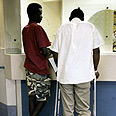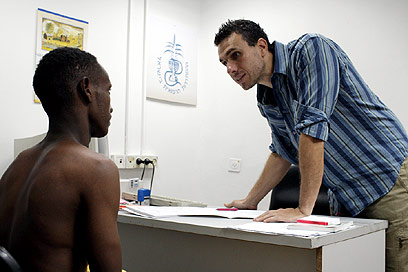
Compassion
Photo: AP
Six months ago, the Physicians for Human Rights (PHR) clinic, which catered to the needs of the foreign workers and refugees in the Tel Aviv area, was forced to shut down.
PHR decided to demonstrate the dire need to allow the refugees – who according to recent assessments number 12,000 – and began shuttling them to the various emergency rooms in the greater Tel Aviv area.
The point was well taken, and the Health Ministry was soon made aware of the overload felt in the hospitals. The result was the induction of the Refugee Clinic. Unlike the foreign workers' clinic, the endeavor was sanctioned by the Health Ministry and the Israeli Medical Association. The clinic is sponsored by donations and its staff is made up entirely of volunteers.
"At this time, the clinic provides immediate medical attention only," said President of the Israel Medical Association Dr. Yoram Balshar. "The clinic is meant to stay operational pending the appropriate Knesset legislation on medical care for refugees. The State has to step up and include refugees in the national health care plan," he added.

Patient at the clinic this week (Photo: Tal Shahar)
However, compassion seems to be the only true resource the clinic runs on. With little medications to disperse, with virtually no medical equipment to speak of and with absolutely no way to run blood tests, or x-rays, all the 80 doctors volunteering at the clinic can do is their best.
"If there is any way for me to help then why not? My skills are needed here" said Dr. Laniado, a pediatrician who also serves as one of the clinic's general practitioners.
The language barriers are hard to overcome, he added, "but between all of us we muddle through somehow."
Ran Cohen, who heads the PHR refugee project, expressed his concerns that the new clinic may be the first and last assistance the State lends the refugees.
"As vital as this project is, it is nothing but a fig's leaf," he said. "I'm not so sure the State sees this as a temporary solution. Morals aside, the fact that refugees are not covered by the National Health Insurance Act is costing us a lot of money.
"When a sick person doesn’t get treatment he gets worse and something that could have been solved with a $5 prescription turns into $800 in hospital bills. Refugees don’t have that kind of money and it becomes a forfeited debt."
"You can't remain indifferent to the refugees' stories," added Erika, the clinic's manager. One of the doctors, she said, was able to pull some strings in order to get a patient an MRI, and another went as far as to buy equipment for the clinic with his own money.
Israel's refugee populations currently numbers about 12,000 people, most of whom fled Sudan and Eritrea; but many are from Africa, the Ivory Coast, Nigeria and Congo. Many fled wars; more have fled religious or political persecution.
Nevertheless, Israel has a relatively small number of refugees living in it: Syria has more than one million refugees and tens of thousands live in Egypt.
Ironically enough, Israel's tough political asylum policies contrast its non-deportation policy, which states that a person cannot be returned to a place in which their lives are in danger. The non-deportation policy was put in place following the 1939 case of the SS St. Louis, whose passengers sailed from Germany to the US in search of sanctuary from Nazi persecution.
The US authorities refused to grant the refuges entry, sending the ship back to Europe. All 936 passengers perished in the Holocaust.
Alma Zohar contributed to this report















